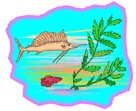Octopus
A lesson on the unique features of the octopus. The reading is accompanied by true/false questions.
Objectives:
• To introduce students to the anatomy and sensory organs of the octopus.
Suggested Grades:
5th Grade - 6th Grade - 7th Grade
Print the reading comprehension worksheet passage and questions (see below).
Students should read the passage silently, then answer the questions. Teachers may also use the text as part of a classroom lesson plan.
Lesson Excerpt:
Cephalopods are members of the mollusk family. While mollusks tend to be viewed as marine animals that have a shell, like clams and snails, cephalopods, which include octopuses and squid, constitute a class under mollusks in the scientific classification of animals. The nautilus, an animal that does have a shell, is also classified as a cephalopod. Cephalopods are characterized by bilateral symmetry. Like humans and other animals that possess bilateral symmetry, cephalopods are equally balanced with similar physical structures on both sides of their bodies. The name cephalopod is derived from ancient Latin and translates to “head” and “foot.” Cephalopods have foot-like appendages that are attached directly to the head; cephalopods do not have a body per se. The scientific study of cephalopods is called teuthology.
Octopus Anatomy
The octopus is one of the most advanced of all the creatures in the ocean because it is highly intelligent due to its well-developed nervous system and brain. The octopus is an invertebrate, an animal without a backbone. Not only is the octopus lacking a backbone, it does not have a skeleton of any sort. The only bony structure in an octopus is a two-part beak that is found inside the mouth.
Continued...

Lesson Printables:
Print this printable worksheet for this lesson:


